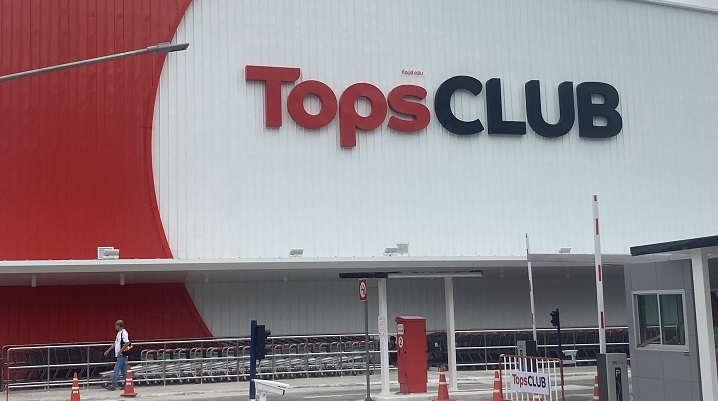All decked out in its red, white and black livery, Tops Club, a new warehouse format created by Thailand’s Central Retail, opened a flagship at Central Rama 2 shopping mall in the southern suburbs of Bangkok on 28 September. Central Rama 2 was already the biggest mall in South Bangkok with a gross floor area of more than 160,000sqm, and Tops Club adds another 15,000, although it is in a separate building that has no common walls with the main mall. The cavernous warehouse, with its concr
ncrete floor and wooden pallets of merchandise piled up high, quickly brings to mind another club format, Costco. There are other obvious similarities: Tops Club is both a retailer and a wholesaler (a format often referred to as ‘cash and carry’ in Asia). The merchandise is sold in supersized packages, and it even sells Kirkland Signature-branded products, which is one of Costco’s private labels. Finally, you can’t shop at Tops Club unless you take out a membership, like Costco.
They say if it looks like a duck, swims like a duck and quacks like a duck, then it is probably a duck, but Tops Club doesn’t quite pass the duck test. It departs from the Costco concept in some key respects and carves out a differentiated space for itself in the pantheon of shopping formats.
The company says that approximately 70 per cent of its approximately 3,700 SKUs are imported. Indeed, the range of imported goods is impressive, much of it unavailable anywhere else in Thailand or hard to obtain. Coles-branded pasta sauce, shitake mushroom and broccoli crisps and huge sides of grass-fed beef from Australia, L’Oréal hair shampoo from China and Rêveur from Japan, hot barbeque rub from Mississippi, sparkling mineral water from Italy, cookies from Denmark, and rice from Hokkaido are all here. But it doesn’t come cheap: you can walk away with a 640g package of Red Rock Deli potato chips imported from New Zealand, but it will cost you 499 THB (about $20). A quick price check reveals that it comes in at roughly the same price as three bags of the same size at Costco in Australia.
A different kind of quack
Tops Club’s target customers are affluent families and younger professionals — same as for Costco — but when Tops ‘quacks’ about all the imported products it offers, it is appealing to a desire for exclusivity and status that isn’t really Costco’s schtick. Of course, Costco never set out to be a real discount concept, but its marketing emphasises national (read: American) brands. Telling its customers in the US and other Western countries where it operates that a large percentage of its merchandise is imported would not necessarily go over well.
The ‘exclusivity’ of the merchandise at Tops Club also suggests the ability to collect higher margins (remember the potato chips) and make it less dependent than Costco on membership fees to turn a company profit. This is a second point of difference. Tops Club has two tiers of membership: the first one is a free sign-up that gives you the right to shop there. The second, more premium, tier will cost 999 THB (about US$28) after 31 October and earns the shopper perks such as 5 per cent discounts and free delivery in the Bangkok metro area for purchases through the Tops Club app. Costco, by comparison, has three paying membership tiers — Executive, Business and Gold Star — and sells its products in bulk at an average gross margin of just over 10 per cent. Its revenue from memberships in 2021 was US$3.9 billion, or 2 per cent of total company revenues. The company made US$6.7 billion before taxes, so membership can be thought of as contributing almost 60 per cent of pre-tax profits.
The shopping experience: slow and furious
The 999 THB membership fee is a low hurdle for middle-class Bangkokians, and on the first Saturday the Club opened, the sign-up area inside the main entrance was going, predictably, at full tilt. After signing up, shoppers start ambling through the general merchandise zone of the warehouse, featuring all kinds of dry food products, health and beauty, outdoor goods, digital products, toys and paper goods, among others. The main aisle is dotted with sampling stations where staff in their red and white uniforms offer treats to eager customers.
From this zone, shoppers can wheel to the left through a kind of small darkened tunnel and arrive in the dry grocery department. At the end of dry groceries is another turn to the left into the dairy, fresh food and wine department. Here, the crowds become dense, as do the lines at the sampling stations where chefs grill and dole out Australian beef on sticks.
Finally, shoppers arrive at the checkouts (about 30 of them, two-thirds for premium members and the rest for regular plebs), and a large café, where they can rest and refuel before exiting the warehouse and taking on the non-trivial task of negotiating the heavy, oozing Saturday afternoon traffic of South Bangkok.
Only the first
Central Rama 2 itself was first opened in 2002 and is undergoing renovation. It is one of four large malls built by Central in a ring around the city, all in densely populated neighbourhoods.
Central, which is an integrated mall operator and retailers, has opened pop-ups of Tops Club at a number of locations around the Bangkok metro area, had an app up and running in July and had reportedly already signed up 12,000 members prior to opening day. The warehouse in Central Rama 2 is likely to be the first of a material number, although the company has not made any definitive announcements of future openings.
Central Retail operates supermarkets in various formats under other Tops banners, including Tops Market, Tops Food Hall and Tops Daily. With the Tops Club format, Central takes another step in living up to its boast to cater to the multiple different needs and lifestyles of Thai shoppers.

